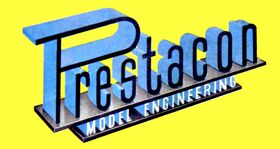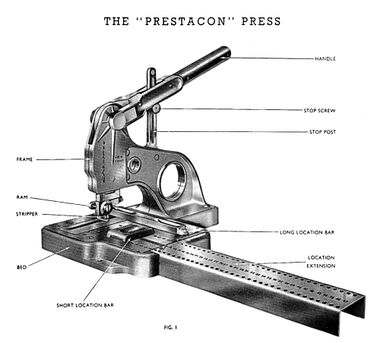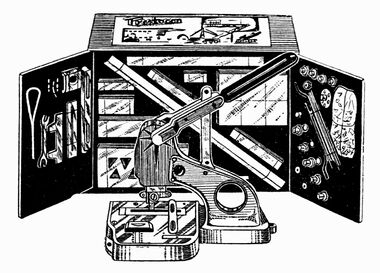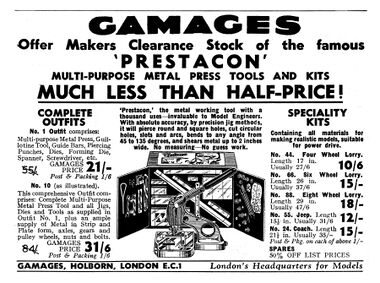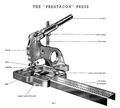Category:Prestacon Model Engineering
| Toy Brands and Manufacturers |
|---|
Prestacon Model Engineering |
| 1947 - 1950 |
~1947: "The Prestacon Press", figure, showing extension bar [image info]
1950: Prestacon lineart [image info]
1950: Gamages- stock closeout advert [image info]
The short-lived Prestacon metal construction kit system (~1947-1950) was superficially similar to the better-established Juneero sets, which had been around since before WW2. Both systems were based around their own special patented punching and bending tool, which was designed to cut tinplated steel in the case of Juneero, and thin aluminium strip in the case of Prestacon.
One of the selling points of the Prestacon system was the tool's array of equally-spaced registration holes (set at quarter-inch ontervals), that let one set end-stops to a range of standard distances ("no measuring!"). For longer pieces of metal there was an extension part that let that the "no measuring" principle still apply to pieces of material that were too big to completely fit onto the base of the tool. A further sophistication was that the spacers were reversible, depending on whether one wanted the bend on a sheet of metal to fit around a given distance (distance plus the thickness of the metal), or inside that distance (distance minus the thickness of the bent metal).
This, of course, assumed that one was using metal of a standard thickness, as supplied by Prestacon.
Functions
- Punch Tool
- – Punching round holes
- – Punching square holes. Primarily to use the tool as a "nibbling tool".
- – Cutting arcs and discs. This could be done using the square punch, if the material had a central hole to be used as a pivot point. Cutting a series of overlapping squares then produced an arc.
- Bending Tool
- – Bending strips
- Guillotine tool (added 1948)
- – cutting strips
Patent
The system's patent appication was submitted in 1944 (and granted in 1946), to a Montolieu Murray Oliphant Irving (British Subject), of 32 Bellingdon Road, Chesham, Bucks.
1948: Free additional guillotine accessory
"We are pleased to announce the production of an efficient GUILLOTINE for use with the "PRESTACON" PRESS, which will accurately shear metal up to 2" in width, and this will add considerably to the usefulness and interest of the Press.
As it is our desire that your press should be kept equipped with the latest developments associated with "Prestacon" model engineering, we take pleasure in enclosing a GUILLOTINE. which we send you without charge so that you will be able to enjoy all the advantages of this new accessory.
"Universal Prestacon" construction sets?
According to the standard manual, Prestacon were also working on a "Meccano-like" system using standardised parts with holes punched at half-inch intervals, to be called "Prestacon Universal". Prestacon could then publish sets of plans for models that could be made using these new standardised parts, and then disassembled for reuse, and the Prestacon owners would be able to would be able to make the parts themselves.
1950: The end of Prestacon?
The September 1950 issue of Meccano Magazine carried a half-page advert from Gamages (just for one month) proclaiming that they'd bought up the stock and were selling it off at half price: this presumably marked the end of the product.
Overview
PRESTACON
An invention that brings real engineering to the Model Maker
WHAT PRESTACON DOES
You can make parts exactly as you want them because you engineer the parts yourself. No more standardised "bits and pieces", but your own precision worked parts that give a realistic look to every model. With the Prestacon Press you can work out your own ideas just as it would be done in a real engineering workshop – and there's no limit to the scope Prestacon gives you. If you are a handyman as well as a model maker, you'll find the Prestacon Press indispensable on hundreds of jobs where sheet metal is used. ... The Prestacon Press pierces round and square holes, cuts straight or curved slots and rectangular and circular holes, and bends metal plates up to 3" wide to angles up to 35°. All these operations can be carried out at any position on a metal plate and each operation can be reproduced on any number of plates with complete accuracy. This is due to an ingenious arrangement of indexed holes into which the "location" or "guide" bars fit at right angles to each other. These guide bars form set edges against which the metal for working is placed. No measurements have to be made by the operator and it only takes a few seconds to change the position of the metal or the operation of the press. The guide bars also provide for a "minus" working which allows for metal thickness when bending or when piercing holes to match inside an angle.
Comparisons with Meccano-like systems
Advantages over Meccano
Like Juneero, the focus of Prestacon was a patented multi-purpose tool that could bend and punch metal, so that instead of buying a set of pre-punched metal strip components to build your model (like Meccano), you instead used the tool to make the specific parts that you needed. This was arguably closer to "proper" engineering and metalworking than Meccano's approach, and to make a largeish model you didn't have to buy huge sets of components, many of which you'd never need, want or use -- you could fabricate just the parts that you needed for a specific project. The results could also look more realistic, as the models wouldn't be riddled with unneccesary holes.
Disadvantages with respect to Meccano
The problem with Prestacon's approach, of only making holes where they were strictly needed, and permanently fixing the parts together, was that after having made a model the user was stuck with it: there wasn't an easy way of disassembling it to reuse the parts and make something else. If you bought a kit to make a truck, and you wanted to play with that truck, then that was fine: however, if you didn't particularly want to keep the truck after you'd made it, and wanted to play by going on to make other things, then perhaps somethong like Meccano was more sensible.
Similarities with Meccano
Some "specialist" parts that could not be realistically be made by the owner were included with the sets, including a steering wheel, some rather nice large vehicle wheels with heavy tyres, and a surprisingly thorough selection of gears.
Patent excerpt
Ths invention relates to a press suitable for finishing parts of strip or sheet material to be used as components in constructional models and for other purposes.
The said parts consist of plates and strips which are required to be perforated so that they can be goined together by rivets, or screws and nuts or self-tapping screws, and which are sometimes required to be bent into angle shape or flanged.
The main object of this invention is to provide a press tool which is capapble of piercing, bending and flanging such parts at accurately predetermined positions, and which can be used by a child or unskilled person with little risk of error.
Another object is to enable the press to perforate and bend or flange strips or sheets of material in such a manner that two or more such parts can be superimposed with perforations in the several parts on each side of the bend line accurately in alignment with each other.
Another object is to enable small variations of predetermined magnitude to be readily introduced into the spacing of perforations or into the overall dimensions of bent or flanged parts for the purpose of avoiding the need for straining the parts in course of assembly of the structure in which they are incorporated.
Another object is to provide, for use With the press, bending tools adapted to form two or three sharp bends in a strip aL bend lines spaced apart by a distance equal to the minimum pitch of perforations that the press is adapted to make.
A press according to this invention includes a worktable the surface of which is provided with at least one row of uniformly spaced holes perpendicular to a reference axis or with a first series of uniformly-spaced slots disposed side by side parallel to said axis, and with two rows of uniformly-spaced holes parallel to said axis or with a second series of uniformly-spaced slots disposed side by side perpendicular to said axis, at least two stop members, one of which is adapted to be engaged in any hole of said one row of holes or any slot of said first series of slots, and the other of which is adapted to be engaged in any corresponding two holes of said two rows or in any slot of said second series of slots, said stop members being adapted to co-operate with two adjacent straight edges of a work-piece in such a manner that, when urged towards said stop members said work-piece is prevented from rotating in its own plane and from advancing more than predetermined distances in directions perpendicular and parallel respectively to said axis, two series of reference markings on said work-table for identifying the several locations of said stop members respectively, and a head carrying a tool-holder which is capable of being reciprocated perpendicularly to said work-table. ...
Outfits
- No.1 – Tools only
- No.10 – Tools, plus a quantity of metal strip, plus a range of accessory parts: wheels and gearwheels, axles, etc.
Kits
probably an incomplete listing:
- No.14 – Two-seater Sports Car
- No.44 – Four Wheel Lorry – 17 inches long
- No.66 – Six Wheel Lorry – 26 inches long
- No.88 – Eight Wheel Lorry – 29 inches long
- No.55 – Jeep – 15½ inches long
- No.24 – Coach – 21½ inches long
External links
patents
Pages in category ‘Prestacon Model Engineering’
The following 2 pages are in this category, out of 2 total.
Media in category ‘Prestacon Model Engineering’
The following 4 files are in this category, out of 4 total.
- Prestacon lineart (MM 1950-09).jpg 2,631 × 1,889; 574 KB
- Prestacon Model Engineering, box logo, colour.jpg 1,800 × 956; 211 KB
- Prestacon, Gamages advert (MM 1950-09).jpg 1,800 × 1,339; 520 KB
- The Prestacon Press (PrestaconIB ~1947).jpg 2,000 × 1,807; 296 KB
